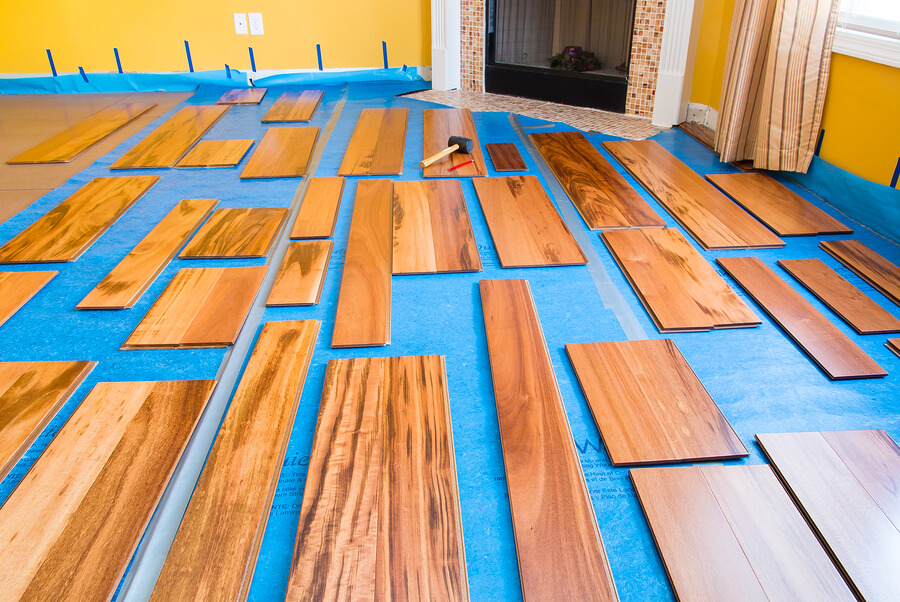Pre-finished vs. Unfinished Hardwoods Part 2: Differences in Installation
- Published By: District Floor Depot

Our last post discussed pre-finished and unfinished hardwood flooring, the differences involved, and a few of the available hardwood finishes. This post expands on that, explaining hardwood types and what is involved in installing unfinished and pre-finished offerings. Learning about these variations can go a long way toward helping homeowners decide which products are right for them.
Types of Hardwood Flooring
It’s crucial to understand a few key terms before choosing flooring for your home. It’s also important to note that varnishing happens on site, regardless of the type chosen. Varnish is the clear, often glass- or plastic-like layer that protects flooring from scratching, scraping, and general wear and tear. Learn these definitions before choosing a flooring type:
Unfinished hardwood — raw, unstained wood installed, stained, and finished on site. This allows homeowners to custom-stain wood to fit their preferences or stain trims to match but involves a longer installation process that tends to require a higher budget.
Pre-finished hardwood — factory-finished wood that is then transported to homes for installation. It requires less time to install because processes like sanding and staining are already completed. Trims cannot be stained to match, and the pre-stained products are often costlier to purchase.
Solid wood — flooring created from one solid piece of wood. It can be sanded or refinished several times in its lifespan and ranges from ¾” to 5/16” in thickness.
Engineered wood — wood flooring comprised of multiple wood or composite veneers, made from the same or different species. Grains run in different directions, and some planks can be sanded or refinished to achieve different coloring.
Consult a flooring expert to decide which options are best for your hardwood flooring project.
Species of Wood Used in Hardwoods
In addition to differences in unfinished or pre-finished hardwoods and solid versus engineered makeups, it’s also good to know a little bit about the species of wood used in hardwood flooring offerings. Here are some distinguishing characteristics of the most popular varieties:
-
- Ash — light tan to dark brown with yellowish hues, bold and moderately open grained, readily available and produced in North America
- Bamboo — imported from Asia, light or yellow tones to dark tan shades, has a distinctive grain pattern that shows stalks, can be horizontally or vertically laminated
- Maple — imported from Africa, medium brown color at installation that can turn darker over time, medium to coarse texture, moderately available
- Oak — reddish when freshly cut, varies from yellow or orange to reddish brown, closed grain with clear to knotty patterns, soft and fairly durable, readily available in North America
- Walnut — imported from Australia, ranges from pinkish to deep burgundy reds, colors become less vibrant over time, moderately available
Other hardwood varieties include beech, birch, Brazilian cherry, cherry, cork, cypress, Douglas fir, hickory pecan, Iroko, jarrah, mahogany, mesquite, pine, purple heart, spotted gum, and teak.
Installation Differences: Unfinished vs. Pre-finished Hardwood Flooring
When it comes to installing these floors, there are a few differences. Pre-finished hardwoods are sanded and finished in a factory, meaning they come to the site ready to cut and install in a homeowner’s room of choice. A layer or two of varnish is applied once they’re installed, but the overall process is cleaner, faster, and more cost-effective than for unfinished varieties.
Unfinished flooring, by comparison, needs to be nailed to a plywood subfloor, sanded down, stained, and then finished in varying numbers of coats. The process is much longer, involving drying time between each of the stain and varnish layers, but the result is much more customized to homeowners’ preferences.
Keep Your Local Flooring Expert in Mind
Deciding which version is right for your home is a personal choice, one you can discuss with a flooring expert to ensure you make the proper decision for your project. When you have questions about unfinished and pre-finished hardwood flooring options, call your local flooring expert. Professionals have years of experience in the field, and they’ll be able to walk through your needs and provide advice to help you make the right home flooring decision.



